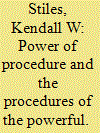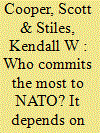| Srl | Item |
| 1 |
ID:
071599


|
|
|
|
|
| Publication |
2006.
|
| Summary/Abstract |
Are certain countries more likely to comply with international law than others? History has provided an interesting test of several competing theories of international rule compliance in the form of the UN Security Council's Resolution 1373 to combat international terrorism. We apply a mix of quantitative and qualitative methods to test the salience of various national characteristics - domestic political culture, national interests, regionalism, dependency, power, international alliance patterns, past patterns of compliance. In the end, while all the factors seem to have a bearing on the outcome, regionalism and past patterns of compliance emerge as particularly significant.
|
|
|
|
|
|
|
|
|
|
|
|
|
|
|
|
| 2 |
ID:
068739


|
|
|
| 3 |
ID:
182681


|
|
|
|
|
| Summary/Abstract |
Studies of NATO rely heavily on military spending as a fraction of GDP as the key indicator of members’ contribution to the alliance, but a growing number of scholars have challenged this approach. We suggest that each member’s public goods provision is a better measure of commitment to the alliance. In the case of post-Cold War NATO, out-of-area troop deployments (adjusted for population) constitute one of the strongest indicators of a state’s contribution to public goods. Providing troops for NATO missions in Afghanistan, Kosovo, and Bosnia-Herzegovina is one of the clearest signals of high commitment to the alliance. Using deployment data from 2004 to 2018, we show that there is evidence of disproportionate burden-sharing within the alliance. Countries like Slovenia, Denmark, the USA and UK contributed far more to NATO deployments than others like Turkey, Spain, Poland, and Portugal. We also use the data to begin examining possible causes of these disparities. We find that wealthier countries, countries that spend more on their militaries, and newer alliance members are more likely to contribute. Our indicator and first-cut model open avenues for further research on why some members demonstrate higher commitment to NATO than others.
|
|
|
|
|
|
|
|
|
|
|
|
|
|
|
|